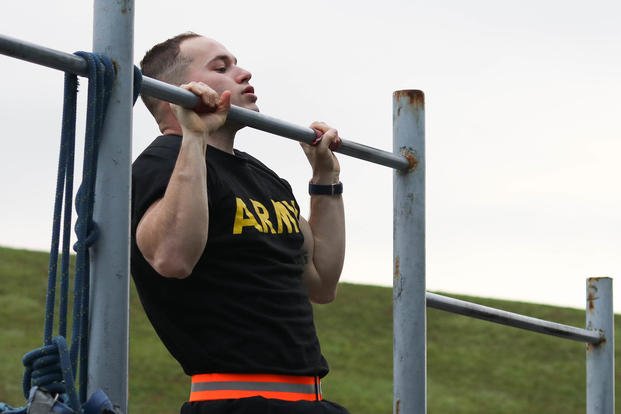The PT Progression Series is a series of answers about how to get better at pull-ups, push-ups and sit-ups for fitness testing, as well as boot camp and for police or fire academies.
Part 3 of the PT Progression Series builds upon a foundation that you have created over the past few months. Once you have mastered the PT pyramid and the superset and can handle workouts with a volume of 100 pull-ups and 200 push-ups, then it is time to test your newfound strength.
This workout will increase your muscle stamina and endurance, which is really the goal of mastering PT tests. The max-rep PT is ideal for those who are stuck in the 10-15 pull-up and 70-80 push-up/sit-up range. In a five- to six-week period of doing this workout just once a week as shown below, most people were in the 20+, 100+, 100+ range on the pull-ups, push-ups and sit-ups tests. But like I said earlier, you need a foundation of fitness before trying this workout.
The new goal is to achieve the volume of PT reps that you are used to in as few sets as possible. For instance, for our standard 100 pull-ups, 200 push-ups and 300 sit-ups workout, the plan is to get these numbers in max-rep sets. It is recommended to do this workout only once a week, but you can combine like this during your week:
Monday (PT pyramid): Build your way up to your max effort on pull-ups and push-ups, return in reverse order. Each week or so, you should see yourself progressing up the pyramid. Eventually, the 1-10-1 pyramid will be easy to do. It may be time to push that to new levels and go for a 12-15 high pyramid.
Wednesday (PT superset): Keep working the volume so you get your goal reps for the day, just as you have been doing for the past several weeks. Start adding harder "rest" elements into the superset circuit. Get some ideas from this circuit training article.
Saturday (Max-rep PT): I recommend taking a PT day off before trying this 100/200/300 rep workout in as few sets as possible for best results. This is very similar to the Murph done by CrossFit gyms but instead of doing 300 squats, replace them with an exercise you will be tested on, such as sit-ups. Focus on maxing out the pull-ups, then move straight to the two-minute push-ups and sit-ups sets without rest, other than a sip of water if you need to hydrate.
Optional Progressions to This Max-Rep PT
Try doing the workout with a weight vest.
Add in running a quarter-mile each set at your goal mile pace you want for the timed run. For example, if you want a nine-minute, 1.5-mile run time, you need to run a 90-second quarter-mile.
Goal: See how few sets it takes you to do this 100/200/300 workout. The best I have ever seen is three sets. Most advanced PTers can do this in four or five. If it takes more than 10 sets, stop at 10 and live to fight another day.
Ultimate progression: If you are kicking everybody's butt in this workout and complete it in three sets, keep doing and see how many reps you can get in five sets. The record in our spec-ops training group was 185 pull-ups, 400 push-ups and 400 sit-ups in five sets. In more than 15 years of doing this workout, I have only seen three guys do this many reps in five sets, which was the time most of the other guys did 100, 200 and 300 reps, respectively.
By the way, these are non-kipping pull-ups. Military-grade pull-ups only.
Complete PT Progression Series
- PT Progression Series #1: PT Pyramids: Do this workout every other day. No workout is good to do daily for long periods of time. It is best to do this foundation workout only three days a week.
- PT Progression #2: Superset: This is another sub max-effort foundation workout to increase the volume of your PT exercises. It is recommended to add this type of workout and replace a pyramid workout once a week so you only total these upper-body workouts only three times a week. Learn how to design a superset effectively.
- PT Progression #3: Max-Rep Set Workout: Once you have mastered the PT pyramid and the superset and can handle workouts with a volume of 100 pull-ups and 200 push-ups, then it is time to test your newfound strength. This workout will increase your muscle stamina and endurance, which is really the goal of mastering PT tests. Find out how to push your numbers even higher.
- PT Progression #4: PT/Run Workout: You can make a pyramid out of this one or make it one tough superset, but each "rest" period between sets is a run of various distances. Learn the best way to add running to the next generation of progression.
- PT Progression #5: PT and Advanced Movements Workout: Add tougher exercises into your pyramids and supersets, such as burpees, push presses, bear crawls, etc.
Stew Smith is a former Navy SEAL and fitness author certified as a Strength and Conditioning Specialist (CSCS) with the National Strength and Conditioning Association. Visit his Fitness eBook store if you're looking to start a workout program to create a healthy lifestyle. Send your fitness questions to stew@stewsmith.com.
Want to Learn More About Military Life?
Whether you're thinking of joining the military, looking for fitness and basic training tips, or keeping up with military life and benefits, Military.com has you covered. Subscribe to Military.com to have military news, updates and resources delivered directly to your inbox.


















